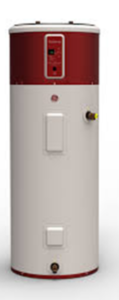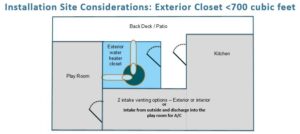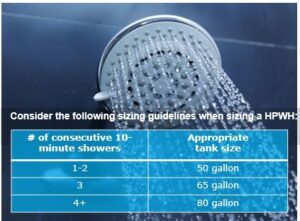Why Heat Pump Water Heaters?
By Nick Brown, President, Build Smart Group
 Heat pumps are used everywhere today – in your refrigerator, your home’s heating, and cooling system, and your car. There’s another great product that has come on the market in the last few years called the Heat Pump Water Heater (HPWH) that uses the same technology used in the heat pump air conditioning system to provide hot water for residences without using natural gas, which makes them better for the environment and healthier for residents. They are also more energy efficient than the gas tankless water heaters that have become the technology of choice over the past decade. Instead of burning fuel directly, they take heat out of the air surrounding the unit – a sort of “free” source of energy.
Heat pumps are used everywhere today – in your refrigerator, your home’s heating, and cooling system, and your car. There’s another great product that has come on the market in the last few years called the Heat Pump Water Heater (HPWH) that uses the same technology used in the heat pump air conditioning system to provide hot water for residences without using natural gas, which makes them better for the environment and healthier for residents. They are also more energy efficient than the gas tankless water heaters that have become the technology of choice over the past decade. Instead of burning fuel directly, they take heat out of the air surrounding the unit – a sort of “free” source of energy.
HPWHs have many benefits for both homeowners and contractors. For homeowners, they reduce energy costs, have longer warranties, have lower carbon footprints, and offer more control over water heating. For contractors, HPWHs are straightforward to install and can have a higher profit margin than standard water heaters. Pair your HPWH with a rooftop solar system, and the economics really sing, as your solar photovoltaic (PV) panels offset the electrical usage of your water heater and bring down your utility bills.
Technology: HPWHs are Simple, Reliable, and Proven
Heat pump water heaters have long been popular in the Pacific Northwest and are gaining traction in other areas of the country as well. For those not familiar with them, heat pumps are nothing new; they have been used for 90 years in our refrigerators and are the most common space conditioning systems in the world. In the refrigerant cycle, ambient air is pulled into the unit and the compressor concentrates the heat surrounding the unit into the water in the tank.
So-called Hybrid HPWHs can operate in four different modes, listed below, which give homeowners more control over water heating. Heat pump only HPWHs are also coming onto the market, and they offer enhanced efficiency but less flexibility to handle occasional spikes in hot water usage.
| Operating Mode | Benefit | Drawback |
|---|---|---|
| Efficient Mode |
Heat Pump Only-Most efficient 300%-400%. | At 9 gallons per hour, it’s slow to recover by itself |
| Hybrid Mode-High Demand Mode | Default setting-A blend between i the HP and electric elements. | Lose some efficiency |
| Electric Mode | Electric elements only. Fast recovery.
Operates if there is a problem with the HP |
Least efficient, same as a standard electric water heater. |
| Vacation Mode | Saves energy when you’re away from | You have to return home. |
Installation: Different, but Doable
HPWHs are typically installed in the corner of the garage or an interior or exterior closet. All that is needed are a 220 Volt circuit with a 30-amp breaker, a drain for the condensate, room to access the air filter and the tank, and airflow. There are no gas plumbing trades needed, no vent for combustion gases to escape, and there is less maintenance involved than with gas tankless water heaters, which require annual flushing.

Garages are the ideal location, but closets can be another good location for HPWHs. A 3-foot square closet with a louvered door is sufficient, and the air flow can be ducted to the outside in lieu of a louvered door if preferred. Care should be taken when installing them in interior closets, as noise could be a factor, but HPWHs are typically only about as noisy as a modern dishw
asher. We also recommend upsizing the tank slightly from the typical gas-fired tank unit. For instance, a 2 to 3-bedroom home should be happy with a 50-gallon unit, but a 4 to 5 bedroom home should go with a 65-gallon or even an 80-gallon unit. The chart below illustrates proper HPWH sizing according to shower patterns in homes. Sized properly, these units have plenty of capacity for California’s families and can do their job efficiently with a lower Carbon footprint.
Costs
A common misconception about HPWHs is that they are significantly more expensive to operate than traditional gas water heaters. The monthly operating costs of a HPWH are very similar to that of a gas tankless system, and the installation costs are comparable and sometimes less. Incentives are available to help early adopters make the switch: $300 would be saved through the ENERGY STAR tax credit, and qualified plumbing and air-conditioning contractors could receive at least $3,000 per installation under the statewide utility TECH incentive program, which rolled out in December 2021 to encourage the removal of gas from California homes. Customers can take advantage of these savings by using a qualified contractor to install their HPWH. If a house were to have a PV system, it could directly power the HPWH, decreasing operating costs even more.
Homeowners are buying HPWHs because of their competitive operating costs, immediate savings through incentives, and low carbon footprints. They afford peace of mind with longer warranties and more control over water heating. Their 93% customer satisfaction rating shows that they meet customer needs and are a great alternative to traditional gas water heating.





